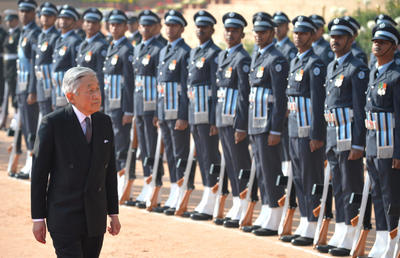Having been blocked by China and Russia from developing significant strategic relations with the Central Asian republics, India has been effectively rendered an island nation. In the face of growing Chinese economic clout within the ASEAN countries and a more assertive Chinese naval presence in the South China Sea, New Delhi has begun to develop a robust strategic partnership with Tokyo to avoid a similar marginalisation in Southeast Asia. If India enters into a genuine maritime alliance with Japan and acts to project naval power in the South China Sea, it could transform the security environment of the Asia Pacific region.
India is well situated to project power in Southeast Asia via its Andaman and Nicobar Islands, located close to the highly strategic Malacca Strait. The Andaman and Nicobar territorial capital, Port Blair, is home to a large naval base and India’s tri-service Andaman and Nicobar Command (ANC). The ANC’s Baaz naval air station, commissioned in July 2012, is located at India’s southernmost point on Great Nicobar Island, only 90 kilometres from the Indonesian island of Sumatra, and dominates the six-degree channel, a major access route to the Malacca Strait.
India’s ability to project power in the South China Sea has already made New Delhi an attractive partner for Vietnam’s offshore hydrocarbon exploration and production. India’s state-run energy company ONGC Videsh Limited (OVL) began commercial production of gas and condensates in Vietnam’s littoral waters in 2003. Despite vocal Chinese opposition, OVL and PetroVietnam signed a three-year contract in October 2012 to expand energy exploration and production off Vietnam’s coast. China views Indian energy development efforts in Vietnamese waters as a direct challenge to China’s claim to sovereignty over those waters and the rest of the South China Sea. In December 2012, the Chinese foreign ministry issued a statement declaring its opposition to oil and gas development in the disputed waters of the South China Sea. The statement was issued in response to remarks by the chief admiral of the Indian Navy vowing to protect India’s assets in Vietnamese waters. Referring specifically to OVL’s hydrocarbon blocks off the coast of Vietnam, the chief admiral told the press that India is prepared to defend against any threat to its interests in the South China Sea.
Already in June 2012, India and Japan held their first joint naval exercise, involving four Indian naval vessels. The regularisation of joint naval exercises, leading to a robust strategic partnership, may enable India to join Japan, as well as the United States and Australia, in a quadrilateral partnership — which Shinzo Abe has termed ‘Asia’s Democratic Security Diamond’. To do so, India will need to alter its policy of strategic autonomy from the United States and, by extension, Australia. New Delhi has traditionally sought to maintain its strategic autonomy, maintaining a conciliatory tone toward Beijing and studiously avoiding being associated with an alliance that seeks to counterbalance China. As late as March 2012, Prime Minister Singh hewed to this line. Participating in the Seoul Nuclear Security Summit, the Indian prime minister expressed his doubts to the South Korean press about the effectiveness of any collective security strategy to contain China and declared his intention for India to maintain its equidistance from Washington and Beijing. But faced with the rapid rise of Chinese power in Central Asia and Southeast Asia, India seems to have modified its orientation and partnered with one of America’s staunchest allies. In his May 2013 Tokyo visit, Prime Minister Singh spoke of the need to improve ‘maritime security across the linked regions of the Indian and Pacific Oceans’, and declared Japan to be ‘a natural and indispensable partner in our quest for stability and peace’.
At the summit, India also agreed to purchase Japanese US-2 amphibious aircraft. Manufactured by ShinMaywa Industries, the search-and-rescue US-2 is the second iteration of ShinMaya’s PS-1 anti-submarine warfare (ASW) aircraft. As Japan prohibits itself from exporting armaments to countries in ongoing conflicts, the US-2 does not carry any offensive capability. However, the amphibious aircraft may be retrofitted with ASW capability and may open the possibility of joint Indo–Japanese weapons development in this field. More immediately significant, the US-2 can quickly be converted for troop-carrying missions. The US-2 sale to India is the most significant export of Japanese defence technology to a major Asian power.
Following the imperial visit, Shinzo Abe is expected to visit New Delhi in January 2014 and be honoured as chief guest at India’s Republic Day Parade. The outcome of Abe and Singh’s second strategic summit may signal the beginning of India’s participation in an alliance of Asian democracies that could further promote free trade and a liberal political order in the region.
Micha’el Tanchum is a Fellow at the Department of Middle East and Islamic Studies, Shalem College, Jerusalem, and at the Asia and Middle East Units, Truman Research Institute for the Advancement of Peace, Hebrew University. Dr Tanchum also teaches in the Department of East Asian Studies, Tel Aviv University.

